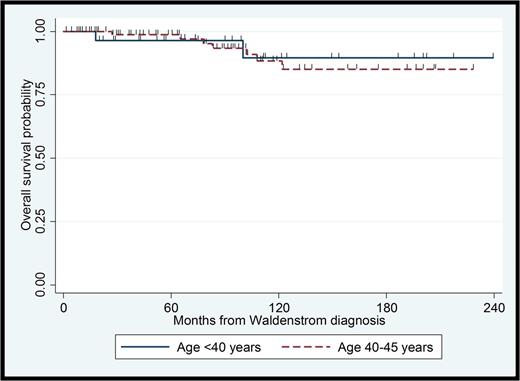Abstract
Introduction: Waldenström Macroglobulinemia (WM) is a rare and incurable lymphoplasmacytic lymphoma that is typically diagnosed at a median age of 69 years. Patients less than 50 years of age account for less than 10% of all WM cases (Castillo Br J Haematol 2015). As such, the clinical characteristics and survival function of these young patients have not been evaluated in detail. This descriptive retrospective study elucidates the clinical features and life expectancy of young patients with WM.
Methods: A retrospective analysis of patients diagnosed with WM before the age of 45 was conducted to elucidate differences in clinical characteristics between patients aged <40 and 40-45 years. Age, sex, hemoglobin, platelet count, serum IgM levels, beta-2-microglobulin levels, percentage of bone marrow involvement and indications to treat were used to compare both groups at initiation of treatment. Differences in clinical presentation between groups was evaluated by the Chi-square and Fisher's exact test when appropriate. Time between diagnosis and initiation of treatment were also compared. Kaplan-Meier overall survival (OS) curves were also generated for both groups and compared using the log-rank test. P-values <0.05 were considered significant.
Results: 124 patients seen at this institution were diagnosed with WM before the age of 45, of which 32 (26%) were less than 40 years old at diagnosis and 92 (74%) were between 40 and 45. 73 (59%) patients were male. For all patients at the time of diagnosis, the median hemoglobin was 11.7 g/dL (4-15.1 g/dL), median platelet count was 247 K/μL (31-526 K/μL), median beta-2-microglobulin 2.2 g/L (0.9-21.7 g/L), median serum IgM level 3,570 mg/dL (398-11,000 mg/dL) and median bone marrow involvement 50% (2-100%). No statistical differences were found in age, sex, hemoglobin, platelet count, beta-2-microglobulin, serum IgM level or bone marrow involvement between both age groups at initiation of first line therapy for WM. 77 (62%) were treated within one year of diagnosis and 26 (21%) were treated after one year post-diagnosis; 21 patients (17%) have not yet been treated with a median time from WM diagnosis of 13 years. 68% of patients diagnosed before age 40 were initiated on treatment within 12 months of being diagnosed compared to 75% of patients in the ≥40 age group. Among the 103 patients who have received WM-directed therapy, the indication for treatment included: symptomatic hyperviscosity (n=43; 41%), extramedullary disease (n=35; 33%), constitutional symptoms (n=35; 33%), anemia (n=20; 19%), and peripheral neuropathy (n=20; 19%). 48% of patients <40 experienced symptoms of hyperviscosity compared with 38% of patients ≥40. No differences between patients aged <40 and 40-45 years were seen for treatment indication with regards to anemia, constitutional symptoms, neuropathy or extramedullary disease (p>0.05 for all comparisons). The median follow-up for all patients was 94 months with a 5-year OS rate of 98%, 10-year OS rate of 89% and a 20-year OS rate of 86%. In patients <40 years, the 5-year OS rate was 96%, 10-year OS rate was 90% and the 20-year OS rate was also found to be 90%. For patients ≥40 years, 5-year OS rate was 99%, 10-year OS rate was 88% and the 20-year OS rate was 85% (See Figure).
Conclusion: It is important to note the unexpected finding that 48% of WM patients <40 years present with symptoms of hyperviscosity at initiation of first line therapy compared to 14% in older WM patients (Gustine Br J Haematol 2017). It seems that younger patients have a greater life expectancy compared with the general population of patients with WM.
Treon: Pharmacyclics: Consultancy, Research Funding. Castillo: Abbvie: Research Funding; Pharmacyclics: Consultancy, Research Funding; Janssen: Consultancy, Research Funding; Millennium: Research Funding.
Author notes
Asterisk with author names denotes non-ASH members.


